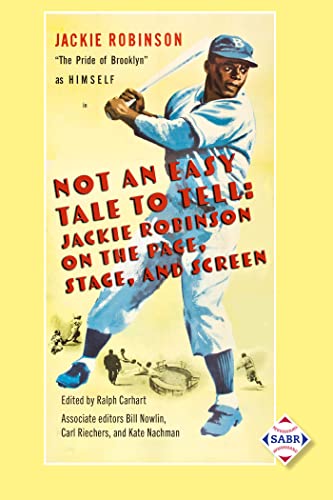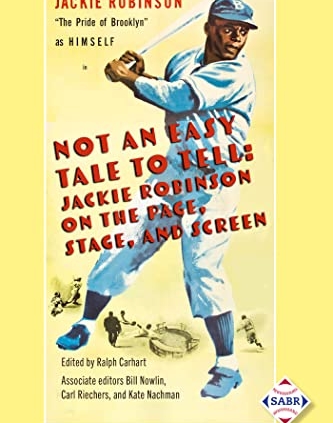Introduction: Not An Easy Tale To Tell: Jackie Robinson on the Page, Stage, and Screen
This article was written by Ralph Carhart
This article was published in Not an Easy Tale to Tell: Jackie Robinson on the Page, Stage, and Screen (2022)
 When Jack Roosevelt Robinson set foot on the green grass of Ebbets Field on April 15, 1947, he understood the enormity of the moment and his role in it. He was breaking through a barrier that had been in place for 60 years, and by doing so was elevating his entire race. He knew the importance of his every action on and off the field, both in how they were perceived by White America, as well as his fellow Black citizens who had longed for this pivotal moment for decades. For certain by the end of his short life, a life spent in activism where he was often the central character, he had some understanding of the impact he would have on history.
When Jack Roosevelt Robinson set foot on the green grass of Ebbets Field on April 15, 1947, he understood the enormity of the moment and his role in it. He was breaking through a barrier that had been in place for 60 years, and by doing so was elevating his entire race. He knew the importance of his every action on and off the field, both in how they were perceived by White America, as well as his fellow Black citizens who had longed for this pivotal moment for decades. For certain by the end of his short life, a life spent in activism where he was often the central character, he had some understanding of the impact he would have on history.
What is less certain is if Jackie Robinson was aware of the profound influence he would have on fiction. The passage of time has elevated him beyond mere trailblazer and placed him closer to the rarified stratosphere of myth. Perhaps the biggest reason for that evolution from man to legend has been the seemingly endless fictional representations that have appeared on movie and television screens, theatrical stages, and pages of novels since he signed his first contract with Branch Rickey on Montague Street in Brooklyn, in 1945.
Almost as soon as he got his first hit with the Dodgers, Robinson became an important character in the American story. He quickly became the exact kind of symbol that Black Americans, and a significant percentage of their White counterparts, longed to elevate. For the latter, the very singularity of his elevation, which should have signified just how far we had to go, instead became “proof” that we were already there. As with the election of Barack Obama as President of the United States 60 years later, Jackie Robinson’s promotion to the Dodgers was, for many, evidence that racism was defeated. He became St. George, slayer of the dragon of hatred and a figure that fiction has, in many ways, completely divorced from reality.
It began with the low-budget 1950 film, The Jackie Robinson Story, which starred the man himself and laid the foundation for many of the simplified myths that have come to be taken as truths of the story of White baseball’s integration. The line between fiction and reality was blurred by the fact that it was really Robinson reciting the lines written for him by Arthur Mann, Branch Rickey’s personal secretary. In the space where altered memories become accepted as hard facts, the truth was garbled by the sound of Robinson’s own voice saying, “Mr. Rickey, I have two cheeks.”
The creators of these fictions are not entirely to blame for their inability to properly represent Robinson in their works. His story, from his birth in Cairo, Georgia to his death 53 years later in Stamford, Connecticut, is one that defies many of the conventional structures of traditional storytelling. He was a socially progressive activist who was a lifelong Republican. He was a proud Black man whose own personal mentors included a roster of important White men, from Branch Rickey, to William Black (the president of Chock Full o’ Nuts Coffee), to New York Governor Nelson Rockefeller. He was a staunchly patriotic American who, later in life, struggled to salute the flag because the country he loved did not love him back.
Beyond all the seeming contradictions, it is difficult to tell the Robinson story because of just how much he accomplished in his short life. His illustrious college athletic career, his brief but important military history, his role as a husband and father, his time in baseball, and his post-playing career that included efforts in business, politics, activism, and philanthropy—to encapsulate all of that into a two-hour Hollywood film is a near impossible task. Perhaps that is the reason few have tried. The only artist who ever attempted to do so in a standard biopic, Spike Lee, found financial backing for his multi-faceted project impossible to come by.
Nearly all the representations of Robinson in fiction instead choose to focus on a particular moment, or the echoes of a specific event. His court-martial for his refusal to sit at the back of a military bus, his brief tenure in the Negro Leagues, his historic 1947 season—each of these account for important individual moments in Robinson’s life, but none of them succeed in encapsulating the full measure of the man.
It is more than just the limits of time that are prescribed to a conventional film script that stand in the way of fiction properly presenting Robinson’s story. It is also because he has become more than just a man. Major-league baseball bears some responsibility for this canonization. Ever since the universal retirement of his number 42 in 1997, there has been an annual tradition of honoring Robinson, his accomplishments, and his sacrifice. As others have pointed out, the festivities have become weighed down with a tragic irony, as the number of Black athletes playing in the majors continues to shrink. As baseball struggles with racial issues it has not properly addressed in the present, it chooses to elevate the moment in its history where it overcame its prejudices and finally became the American Pastime. Robinson, of course, is the central figure in that tale, a tale that has come to represent much more than the drama that unfolded on a baseball diamond 75 years ago.
The elevation of Robinson from man to legend was not assured. After the release of Story, it took 30 years before another high-profile attempt at telling Robinson’s tale. The hesitation was an old refrain. Wealthy, largely-White producers balked at making a financially risky investment in a project with a Black man as the central character, especially if it did not involve explosions or chase scenes. It took almost a decade after Robinson’s death, after both the family and society had a chance to assess his legacy, that the proliferation of the fictional character of Jackie Robinson started to flood the public consciousness.
This volume takes a look at the evolution of Robinson the man into Robinson the symbol, and how artists of various stripes have helped to create that character. He has been the central figure in two big screen adaptations, a Broadway musical, countless children’s theatre productions, a pair of thriller novels, several television films, a comic book series, a jazz suite, and even in the written works of his own daughter, Sharon Robinson. Some of these works have the approval and cooperation of the family. Others do not. Robinson has also appeared as an off-screen or minor character in countless other creations. He has become a symbol so embedded in the national psyche that his presence in any tale automatically harkens to the idea of possibility, of perseverance, of right defeating wrong, of all that is good in the American mythology.
The tragic cost of that fictionalization is that for all but historians and the most ardent of baseball fans, the complexity of the man that was Jackie Robinson has been simplified. We do stray from the fictional Robinson in this book. We explore the multiple appearances he made on television as a guest on game and talk shows, as well as his time as the host of his own radio program. We also look at Ken Burns’s epic documentary entitled, simply, Jackie Robinson. It is in this lone case, where the filmmaker had the luxury of a four-hour running time and the stringent rules of relating history, that we get anything close to a whole-picture view of Robinson.
For all that is lacking when a work of fiction attempts to portray Robinson, there are reasons why artists keep trying—why, in fact, we saw fit to combine to write this very book. Simply put, every now and then, one of them succeeds. Perhaps it is only for a moment, like Chadwick Boseman’s explosive anguish as he smashes a bat to kindling in 42, or in Andre Braugher’s untapped rage as he is arrested by military police in The Court-Martial of Jackie Robinson. Or maybe it’s found in an awkward, tender exchange between Robinson himself and Hollywood and Broadway legend, Ruby Dee, which reminds us that Robinson’s story is not only one of anger, but love. It can even be found in taking the creative leap to feature a Robinson who, like St. George anew, slays the Lovecraftian monster Cthulhu, using only his Louisville Slugger.
The other reason that artists keep returning to Robinson is because he is one of the most inspirational figures of the twentieth century not in spite of, but because of his complexities. He did more than change the game of baseball. He changed America, and by doing so inspired multiple generations of artists to look to him to help tell their stories. That truth is just another contradiction. For, in utilizing Robinson as a symbol, they invariably highlight, time and again, how his actual story is not an easy tale to tell.
RALPH CARHART is the author of The Hall Ball: One Fan’s Journey to Unite Cooperstown Immortals with a Single Baseball [McFarland 2020], and the creator of the eponymous artifact that visited with every member of the Hall of Fame, living and deceased. With Not an Easy Tale to Tell, Ralph has contributed to six SABR volumes. His latest effort for SABR was the biography of Rachel Robinson, which appeared in 2021’s “Jackie: Perspectives on 42.” He is currently writing a history of Brooklyn, dating back to the Lenape Indians, as told through the lens of baseball.
- Read more: Find all essays from Not an Easy Tale to Tell in the SABR Research Collection online
- E-book: Click here to download the e-book version of Not an Easy Tale to Tell for FREE from the SABR Store. Available in PDF, Kindle/MOBI and EPUB formats.
- Paperback: Get a 50% discount on the Not an Easy Tale to Tell paperback edition from the SABR Store ($12.95 includes shipping/tax; delivery via Kindle Direct Publishing can take up to 4-6 weeks.)


